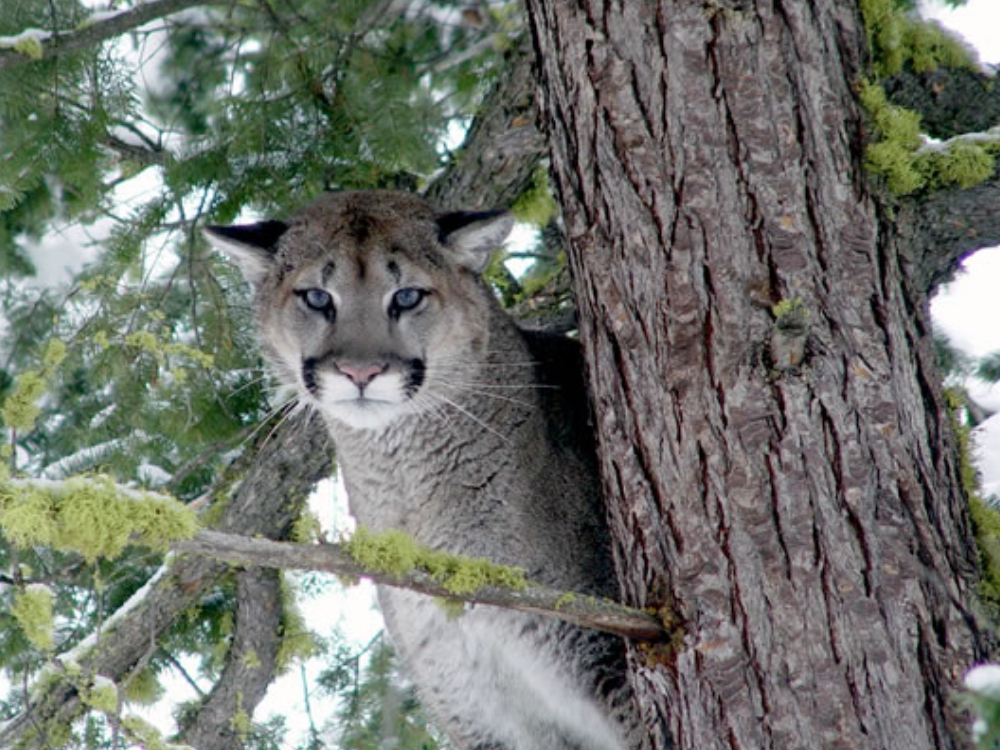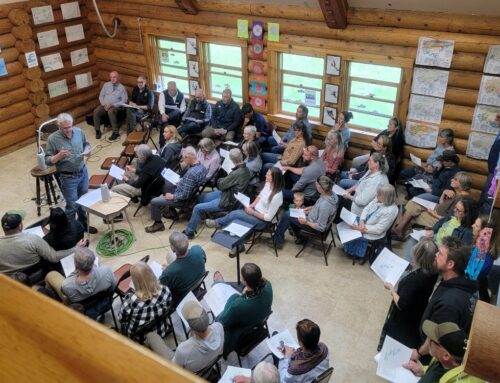Sharing space with Washington’s wildlife
information and photos from Washington Department of Fish & Wildlife Blog
Autumn is a popular time for many to get outdoors and enjoy all of the wonderful opportunities Washington has to offer. Whether hiking in to view autumn colors, scouting your next hunting location, or bringing the family to your favorite fishing spot, there are so many ways to enjoy autumn outdoors in Washington.
Autumn is an important time for wildlife, too. Different species are taking time this season to feed, breed, and prepare for the upcoming winter. When you head outdoors this time of year, there are simple things to remember that can help you coexist with our Washington wildlife this season.
“Deer Crossing”
The deer mating season, known as the rut, typically begins in late October in Washington and lasts into December. The elk rut typically begins mid- to late-September and lasts into mid-October.
During this time, deer and elk (known as ungulates) are more active, travel farther distances, and can be distracted by the prospect of attracting a mate. All of this combines to increase the risk of vehicle-ungulate collisions this time of year. Wildlife may also be attracted to salt used to de-ice roads in the colder parts of the state.

As you’re driving across Washington this autumn, be especially mindful of wildlife crossing or standing on the side of roadways. Abide by speed limits and other posted traffic rules and heed the notice of wildlife crossing signs. As always, adjust your driving accordingly based on conditions and avoid driving distractions.
WDFW works with the Washington State Department of Transportation to reduce the risk of wildlife collisions on Washington’s roadways. Learn more on WSDOT’s website.
Please don’t feed the wildlife!
As the weather cools and people start thinking about the cold winter days ahead, some people start worrying about their backyard wildlife and if they will have enough resources to survive the winter.
Many people see the deer becoming more present in their yards or on their property and try to help them by providing all kinds of feed, from hay or grain to apples and kitchen scraps.
But wildlife usually don’t need our help to survive the winter. Deer, elk, and other animals have developed adaptations that allow them to survive harsh winter conditions without human intervention. These adaptations include building fat and muscle during the summer growing season, migrating long distances to avoid harsh conditions, dispersing across the landscape to reduce concentrations, lowering metabolic rates during the winter season, and restricting movements during severe winter conditions to conserve energy.
The best way to help wild animals survive a severe winter is to promote year-round quality habitat. If animals go into the winter in good condition, most are able to survive persistent deep snow, ice, and cold temperatures. Another way to help wild animals in winter is to avoid disturbing them. Animals must conserve their energy to survive winter conditions, and human disturbance causes them to move about more than they otherwise would.
Feeding your neighborhood deer can cause more harm than good. The digestive systems of free-ranging elk and deer are not able to use many types of artificial feed efficiently. Fruit and grains are not a normal part of a deer’s diet and can be extremely difficult for deer to digest. Their digestive system needs time to adjust to changes in diet, and they can die when experiencing a rapid transition from normal forage to non-natural feed. Corn and apples are especially hard for them to digest.
Learn more on our wildlife feeding webpage.
Wildlife live here
No matter the season, it’s important to remember that we share public lands and other outdoor spaces with many species of wildlife.
Many of the activities we enjoy take place within wildlife habitat, and our actions can influence wildlife behavior — for better or for worse. Remember to practice good land stewardship when enjoying your autumn outdoor activities.

Cougars
WDFW sometimes receives an increase in reported cougar sightings this time of year.
Cougars follow their food, mainly deer, which may move to lower elevations or nearer human development as winter nears and conditions in the high country get more challenging.

Photo credit: Richard Beausoleil, Department of Fish & Wildlife
Relatively few people will ever catch a glimpse of a cougar, much less confront one. However, if you do encounter a cougar on the trail or elsewhere, some tips can help prevent conflict between you and the animal:
- Do not run. Running and rapid movements may trigger the cougar’s instinct to chase. Stop and immediately pick up any small children or pets.
- Face the cougar. Talk to it firmly while slowly backing away. Always leave the animal an escape route, but do not take your eyes off of it. Do not crouch down or try to hide.
- Try to appear larger than the cougar. Make yourself taller by stepping up onto a rock or stump if it is safe to do so. If you are wearing a jacket, hold it open to further increase your apparent size. If you are in a group, stand shoulder-to-shoulder to appear intimidating.
- Never approach the cougar, especially if it is near a food source or with kittens. Do not offer the cougar food.
- If the cougar does not flee, be more assertive. If it shows signs of aggression (crouches with ears back, teeth bared, hissing, tail twitching, and hind feet pumping in preparation to jump), shout, wave your arms and throw anything you have available (water bottle, book, backpack). The idea is to convince the cougar that you are not prey, but a potential danger.
- If the cougar attacks, fight back. Be aggressive and try to stay on your feet. Cougars have been driven away by people who have fought back using anything within reach, including sticks, rocks, shovels, backpacks, clothing — even bare hands. If you are aggressive enough, a cougar will flee, realizing it has made a mistake. Pepper spray in the cougar’s face is also effective in the extreme unlikelihood of a close encounter with a cougar.
Learn more about preventing conflict with cougars on our cougar webpage.
Mountain goats
Another species you might encounter during your outdoor adventures is the mountain goat. Although typically shy, mountain goats can learn to approach people and become too curious, or even potentially dangerous, in an effort to satisfy a craving for minerals and salt. When people visit mountain goat habitat, usually on popular alpine hiking trails, some unwittingly condition goats with their behavior. Urinating near trails adds salt and minerals to the environment. Hand-feeding goats can provide salt and minerals in both the food offered and in the sweat on hands. When goats drawn to these sources of salt are not deterred, they become habituated to people and lose their natural avoidance response.

Habituated mountain goats allow people to observe and approach them at closer proximity than normal, and when goats become insistent on obtaining salt or food, they can become potentially dangerous. Despite their seemingly docile nature, mountain goats are aggressive with each other, using their sharp horns in such interactions. Habituation to people can lead to a very dangerous situation, with goats using their horns to injure people.
Follow these tips to avoid habituating mountain goats to humans:
- Maintain a distance of at least 50 yards from mountain goats; instead of getting closer for a view or photograph, use binoculars and a telephoto camera lens.
- Never offer food to mountain goats, or any other wildlife.
- Urinate at least 50 yards away from a hiking trail; salt in urine can attract mountain goats.
- Leave pets at home when hiking in mountain goat habitat.
- Do not touch, crowd, or chase a mountain goat.
- Do not allow a mountain goat to approach too closely; yell loudly, wave your arms or an article of clothing, and if needed, throw rocks at the goat.
- Avoid hiking alone in areas where mountain goats are habituated to people; in the event of an attack, hiking partners may be able to help.
Learn more on our mountain goat webpage.
Bear necessities
In autumn, bears are hard at work searching for plenty of food so they can fatten up for the winter ahead. This time of year, black bears are foraging up to 20 hours a day in a race against the clock. This annual power-eating marathon is called hyperphagia. During hyperphagia, bears need to eat 10 times the calories they normally consume — that’s at least 20,000 calories a day. Their goal: put on as much weight and insulating fat as possible before turning in for the winter. Bears that live in warmer climates and den up later, or not at all, still go into hyperphagia in the fall.*

WDFW is asking anyone who lives in bear country to secure trash, remove bird feeders, and pick fruit from trees this fall. This is a crucial time of year for bears to put on as much weight as possible prior to entering their dens, and they are looking for calories anywhere they can get it. Don’t make your neighborhood more attractive to a black bear than what nature can provide in the forest. Remember, feeding or negligently attracting black bears or other large wild carnivores is illegal.
Learn more about living with black bears and preventing conflict on our black bear webpage.
*Content adopted from BeBearwise.org
More Information
Autumn is a beautiful time of year in Washington, and these tips can help you enjoy the season while coexisting with wildlife.
Visit our website for more information about visiting WDFW-managed and other public lands, and don’t hesitate to contact your nearest WDFW office if you have questions before you go. Happy trails!

Klickitat Wildlife Area










